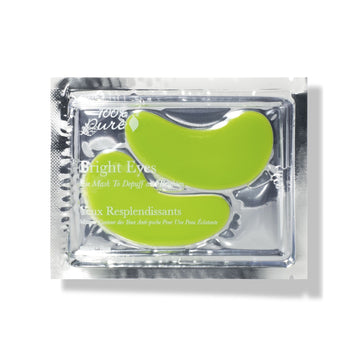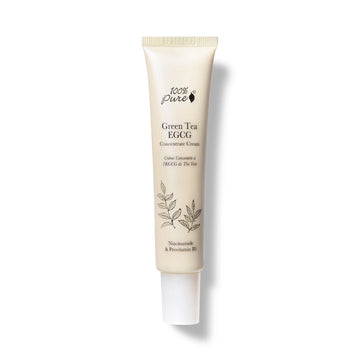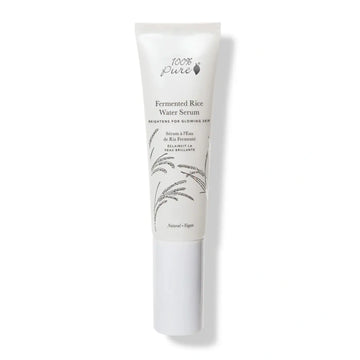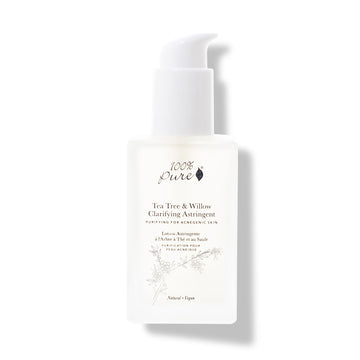Chill Your Way to Radiant Skin: Unlocking the Power of Ice Therapy
Posted on September 12, 2024 Written by: 100% PURE®
Have you ever wondered if something as simple as ice could be the ultimate secret to flawless skin? It might sound like a trick from your grandmother’s beauty playbook, but skin icing is making a modern comeback, and for good reason.
This age-old technique is being celebrated anew for its ability to tackle a host of skin concerns, from puffiness to redness, and even acne. As skincare enthusiasts search for effective, low-cost solutions, the humble ice cube is having its moment in the spotlight.
Let’s discuss why this frosty facial trick is being hailed as a game-changer in the beauty community.
Understanding Skin Icing
Skin icing is a skincare technique that involves applying ice or cold packs to the face to improve the skin's appearance. This method, rooted in the science of cold therapy, works by constricting blood vessels, reducing inflammation, and tightening the skin.
The cold causes a boost in blood circulation once the skin warms up, bringing oxygen and nutrients to the surface, which can result in a glowing complexion.
Historically, skin icing has been used for centuries, with roots in ancient practices where cold was applied to reduce swelling and promote healing.
The Benefits of Skin Icing
Skin icing offers several impressive benefits that make it a popular addition to skincare routines:
Reduces puffiness and inflammation: Constricts blood vessels to calm swelling, especially around the eyes.
Improves blood circulation: Enhances blood flow, giving the skin a natural, healthy glow.
Minimizes pore appearance: Tightens skin, reducing the look of pores for a smoother complexion.
Soothes acne and redness: Calms irritated skin and reduces breakouts.
Boosts product absorption: Prepares the skin to better absorb serums and creams, maximizing their effectiveness.

How Skin Icing Works
Skin icing leverages the body’s natural physiological response to cold to enhance the skin’s appearance and health. When the skin encounters cold temperatures, blood vessels constrict in a process called vasoconstriction. This reduces blood flow to the area, helping to minimize inflammation, puffiness, and redness. It’s particularly effective for reducing under-eye bags and calming irritated skin.
Once the cold is removed and the skin begins to warm up, the blood vessels expand in a process known as vasodilation. This increase in blood flow brings a surge of oxygen and nutrients to the skin’s surface, promoting a healthy glow and aiding in the repair of damaged skin cells. The alternation between constriction and dilation stimulates circulation, which can enhance skin tone and overall radiance.
Additionally, skin icing helps stimulate lymphatic drainage, which is essential for reducing fluid retention and detoxifying the skin. By promoting the removal of excess fluids and toxins, this process can reduce puffiness and give the face a more sculpted appearance. At a cellular level, cold exposure can tighten skin, minimize pore size, and improve skin texture, making skin icing an effective, natural method for achieving a smoother and more youthful complexion
Types of Skin Icing Methods
Skin icing is a versatile and accessible skincare technique that harnesses the power of cold to rejuvenate the skin. Here are some tips that you can try to incorporate skin icing into your routine:
Traditional ice cube technique
This classic method involves wrapping an ice cube in a soft cloth and gently massaging it over the face. The cold temperature helps to reduce puffiness, soothe irritation, and temporarily tighten the skin. It’s an easy and cost-effective way to incorporate skin icing into your routine.
Ice rollers and globes
Designed specifically for facial use, ice rollers, and globes are filled with a cooling liquid or gel. They provide a consistently cold temperature and a gentle massaging action that can improve blood circulation, reduce swelling, and enhance lymphatic drainage. These tools are easy to use and offer a more controlled way to ice the skin.
Cryotherapy tools
These advanced devices deliver more intense cold therapy to the skin, offering benefits like deeper penetration, enhanced skin tightening, and improved anti-aging effects. Cryotherapy tools are often used in professional settings but are increasingly available for at-home use.
DIY cold spoon method
A simple and effective technique where metal spoons are chilled in the freezer and then applied to the face, particularly under the eyes, to reduce puffiness and soothe tired skin.
Sheet masks with cooling properties
These masks are infused with ingredients that provide a cooling effect, helping to hydrate the skin while reducing redness and inflammation. They offer a convenient way to enjoy the benefits of skin icing without direct exposure to ice.
Incorporating Skin Icing into Your Routine
To get the most out of skin icing, it’s important to know when and how often to do it. The best times to ice your skin are in the morning to reduce puffiness and refresh your complexion, or in the evening to calm the skin and prepare it for nighttime products.
For most people, icing 3 to 4 times a week is sufficient, though it can be done daily if your skin tolerates it well. Start by cleansing your face, then gently glide an ice cube wrapped in a cloth or use an ice roller across your skin in circular motions for about 1-2 minutes.
Avoid applying ice directly to the skin for extended periods to prevent frostbite or irritation, and always follow up with a moisturizer to lock in hydration.
Remember to listen to your skin—if it becomes too sensitive or irritated, reduce the frequency or stop icing altogether.
Targeting Specific Skin Concerns with Icing
De-puffing under-eye areas: Gently ice the under-eye region to reduce puffiness and dark circles.
Calming inflamed acne: Apply ice to inflamed acne to reduce redness and swelling.
Soothing sunburns and irritation: Ice can help alleviate the discomfort of sunburns and other skin irritations.
Pre-makeup icing for smoother application: Use icing to create a smooth base for makeup, reducing the appearance of pores and fine lines.
Combining Skin Icing with Skincare Products
Cold temperatures from skin icing can enhance the absorption of skincare products. When the skin is chilled, blood vessels constrict, which allows products to penetrate deeper and work more effectively.
For the best results, apply hydrating serums or soothing creams after icing. This helps lock in moisture and maximizes the benefits of both the icing and your skincare products.
You can also create ice cubes with skin-benefiting ingredients. Freeze green tea or cucumber juice in ice cube trays to combine the cooling effects of icing with the added advantages of these ingredients, boosting your skincare routine.
Potential Risks and Precautions
- Always wrap ice in a cloth to prevent frostbite or irritation.
- Limit icing to 1-2 minutes per area to avoid potential skin damage.
- Sensitive or extremely dry skin types should use icing sparingly.
- Avoid icing if you have broken skin or severe conditions like rosacea.

100% PURE Products to Enhance Your Skin Icing Routine
100% PURE offers a range of high-quality skincare products designed to complement and amplify the benefits of skin icing. Each product is crafted with natural, effective ingredients to enhance your routine and target specific skin concerns:
Caffeine Mask: This mask is infused with caffeine, known for its cooling and de-puffing properties. It helps to invigorate tired skin and reduce swelling, making it a perfect companion for morning skin icing sessions. The caffeine not only soothes but also tightens the skin, enhancing the overall appearance and feel.
Fermented Rice Water Serum: Rich in nutrients, this serum boosts skin brightness and radiance after icing. Fermented rice water is known for its ability to improve skin tone and texture, making it an ideal follow-up product to lock in the benefits of your icing routine and promote a luminous complexion.
Green Tea EGCG Concentrate Cream: This cream is packed with EGCG, a powerful antioxidant found in green tea. It helps to protect the skin from environmental damage and soothe inflammation, complementing the benefits of icing by adding an extra layer of antioxidant defense and calming the skin.
Bright Eyes Mask: Specifically designed for the delicate under-eye area, this mask enhances the effects of under-eye icing. It targets puffiness, dark circles, and fatigue, leaving the eyes looking refreshed and rejuvenated. It’s a great addition to your routine for a bright and youthful gaze.
Tea Tree & Willow Clarifying Astringent: Ideal for acne-prone skin, this astringent combines tea tree oil and willow bark to clarify and soothe the skin post-icing. It helps to reduce excess oil, minimize blemishes, and calm inflammation, making it a valuable tool for maintaining clear and healthy skin.
Frequently Asked Questions
How long should I ice my face for optimal results?
For the best results, limit icing to 1-2 minutes per area of the face. This duration is typically enough to reduce puffiness and promote circulation without risking skin irritation. Overexposure to ice can lead to redness or discomfort, so it's important to keep the sessions brief and gentle.
Can skin icing help with wrinkle reduction?
Yes, skin icing can assist in temporarily reducing the appearance of wrinkles. The cold causes blood vessels to constrict, which tightens the skin and can smooth out fine lines. Additionally, improved circulation from icing can support overall skin health and firmness, contributing to a more youthful look. However, it’s not a permanent solution for wrinkles and should be used in conjunction with other anti-aging treatments.
Is it safe to do skin icing every day?
While daily skin icing can be beneficial for some, it's generally advisable to limit it to 3 to 4 times a week. Frequent icing can potentially lead to over-sensitization or irritation, especially if your skin is sensitive or dry. Monitor your skin’s response and adjust the frequency as needed to avoid adverse effects.
What's the difference between using an ice cube and an ice roller?
An ice cube provides a direct, localized cooling effect and can be a bit uneven in application. In contrast, an ice roller is designed to glide smoothly over the skin, offering a more even and controlled cooling experience. The roller’s massaging action also enhances blood circulation and can make the process more comfortable and effective.
Can skin icing cause broken capillaries or other skin damage?
While skin icing is generally safe, improper use can lead to skin issues. Direct and prolonged contact with ice can cause irritation, redness, or even broken capillaries, especially in sensitive areas. To avoid these risks, always wrap the ice in a cloth and limit icing sessions to a few minutes, ensuring that you don’t apply excessive pressure or cold.
- Tags: September-2024, Skin Care, skincare
We carefully hand-select products based on strict purity standards, and only recommend products we feel meet this criteria. 100% PURE™ may earn a small commission for products purchased through affiliate links.
The information in this article is for educational use, and not intended to substitute professional medical advice, diagnosis, or treatment and should not be used as such.
















